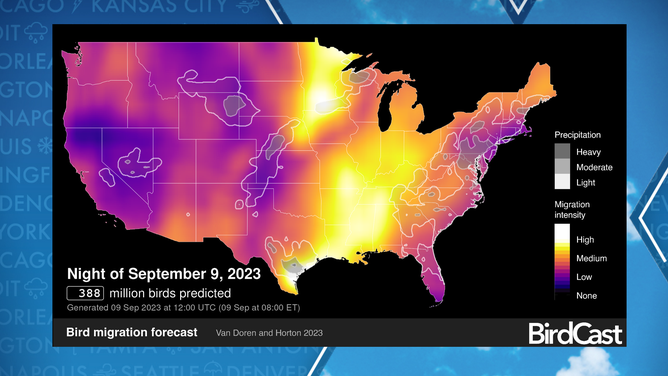Over 300 million birds start annual fall migration to the South for the winter
According to experts, some 4 billion birds will migrate from Canada into the U.S. while billions of others will leave the U.S. and head towards Central and South America.
California paraglider flies with the birds
Paraglider pilot and falconer David Metzgar shows FOX Weather correspondent Max Gorden the wild world of parahawking.
Every spring and fall, billions of birds migrate through the country in an effort to find a sustainable ecosystem to make it through the upcoming months – an annual tradition that is now underway as the U.S. heads towards autumn.
According to experts BirdCast, which is powered by Colorado State University and the Cornell Lab of Ornithology in New York, more than 300 million birds took flight on Saturday for their annual migration to more southern climates.
According to the experts, birds are in search of climates that will provide more food and daylight hours as the world heads towards the winter equinox.
The annual migration begins in August and lasts through November, but September and October are considered to be the peak months in North America.
THESE MAJOR US AIRPORTS SEE THE MOST WILDLIFE-AIRCRAFT COLLISIONS

Bird migration forecast
(Van Doren, B.M. and Horton, K.G. BirdCast, migration forecast mapCornell Lab of Ornithology and Colorado State University. / FOX Weather)
"We've discovered that each autumn, an average of 4 billion birds move south from Canada into the U.S. At the same time, another 4.7 billion birds leave the U.S. over the southern border, heading to the tropics," Adriaan Dokter, a researcher at the Cornell Lab stated during an extensive study. "In the spring, 3.5 billion birds cross back into the U.S. from points south, and 2.6 billion birds return to Canada across the northern U.S. border."
Some of the more well-known species that take part in the annual tradition include Canadian geese, hummingbirds, doves and cranes.
Some of the birds are thought to fly only a few hundred miles, while others fly entire continents, depending on what their particular ecosystem needs are.
The precise timing varies each year, but according to the National Wildlife Federation, some birds will start their return in February, while others may wait to as late as May.
HOW WEATHER RADAR IS TRACKING BIRDS’ MIGRATORY PATTERN
Not all migrations go according to plan, and natural disasters such as hurricanes or even illuminated buildings can alter their flights and lead to deadly consequences.
Due to birds’ exposure to human influences, the experts behind BirdCast have advocated for all to participate in a movement called "Lights Out."
The group says light pollution leads to disorientation of birds, leading to many of the more than 300 million that die in collisions with buildings each year.
The first "Lights Out" program in the United States started in 1999 in the Windy City and has expanded to dozens of other communities in the decades since.
Simply turning off or dimming non-essential lightning from 11 PM until 6 AM during critical migration periods can lead to less light pollution.
Buildings from the Midwest to the Gulf Coast participate in the effort, including the iconic Gateway Arch in St. Louis, Missouri.
The 630-foot-tall monument sits right beneath what is considered to be a major migration highway, so for a period of several weeks in May and September, non-essential night lights are turned off.
The arch’s exterior lights are expected to be turned back on in October.

UNITED STATES - 2023/03/30: Sandhill cranes (Antigone canadensis) flying in the evening to their roosting places near Othello, Adams County, Eastern Washington State, USA.
(Wolfgang Kaehler/LightRocket via Getty Images / Getty Images)
